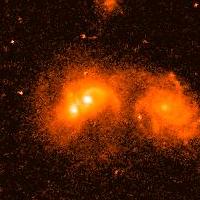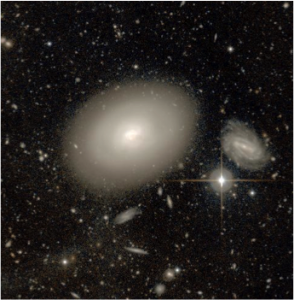Post-Starburst Quasars – Starburst-AGN Connection
In merger-driven evolutionary scenarios, mergers trigger starbursts and the ignition of active galactic nuclei (AGN) that can in turn inhibit both star formation and its own fueling through feedback. A natural consequence of such models is the existence of objects that have luminous quasar activity, starburst or post-starburst signatures, along with indications of a recent merger, such as tidal debris, multiple bright clumps and asymmetries.
Post-starburst quasars (PSQs) are an interesting type of hybrid galaxy that harbor both a post-starburst stellar population and luminous active galactic nuclei (AGN). The starburst is hundreds of millions of years old with a mass on the order of 10 billion solar masses. This type of hybrid galaxy provides a natural laboratory for studying the role AGN play in galaxy evolution (i.e., the black hole mass-galaxy bulge mass relation).
Our studies of PSQs at z ~ 0.3, test the idea that PSQs are a phase in the life of galaxies triggered by external events (e.g., mergers, tidal interactions) or whether they are a more heterogeneous population in which multiple mechanisms can contribute to the class (i.e., external events and internal processes). This project is devoted to understanding the properties of PSQs and is comprised of multiple sub-projects:
- Press Releases: Astronomy Magazine, Universe Today, Physics.org, Phil Plat the Bad Astronomer for Discover Magazine, University of Wyoming
- two-dimensional image analysis with HST imaging and characterization of PSQ morphologies, ADS link 2011ApJ…741..106C
- determination of stellar population ages and masses and quasar black hole masses and accretion rates via spectral modeling of Keck and KPNO spectroscopy, ADS link 2013ApJ…762…90C
- comparisons of PSQ properties with other galaxy types and models, (submitted)
- mid-infrared spectral properties of PSQs, ADS link 2013ApJ…772…28W
- M-sigma relation of PSQs, ADS link 2012ApJ…756..162H
- Integral Field Unit Spectroscopy of PSQs, ADS links 2013MNRAS.428..867S and 2014MNRAS.443..584S
- new catalog of PSQs (coming soon!)
AAS 223 DC Update: After missing my flight to DC and my scheduled AAS talk I was bummed out, but thanks to an excellent suggestion by Danny Dale and an awesome session chair (Dale Kocevski) I was able to make up the talk at the Wednesday AGN session. Super relieved that everything not only went smoothly, but there were a ton of questions, interest on the topic and quite possibly some new excellent collaborations sparked. Check it out!
Starburst-Shocked Connection
The massive amount of kinetic/mechanical energy generated by radio emission in active mechanical-mode galaxies can, when coupled to the gas in the host galaxy, prevent star formation. This scenario predicts a large population of “Green Valley” objects which can be explained by mechanical-mode AGN hosted by galaxies with massive post-starburst stellar populations (or quenched star formation).
We have embarked on a multi-wavelength (optical, NIR, FIR and Radio) study of (extremely) shock/turbulence dominated galaxies to determine how important turbulent (mechanical) energy dissipation is to galaxy evolution. Furthermore, mounting evidence suggests that turbulent energy dissipation is important in some massive nearby systems involving high velocity collisions and in many local radio galaxies.
Our papers:
- Shocked Post-starbust Galaxy Survey I: Candidate Post-Starbust Galaxies with Narrow Emission Line Ratios Arising from Shocks, in preparation
- Catching Quenching Galaxies: The Nature of the WISE Infrared Transition Zone, ADS Link 2014arXiv1409.2489A
Dual Active Galactic Nuclei (AGN)
In theoretical major-merger evolutionary scenarios, galaxy-galaxy dynamical interactions can funnel fuel into the center of the galaxy triggering both star formation and an active galactic nuclei (AGN). Thus as a natural consequence, we should find systems with two or more accreting supermassive black holes (SMBHs) ‘caught in the act’ of merging. Until recently, only a few such dual AGN were known.
Now systematic searches are yielding catalogs of dozens of confirmed systems hosting two or more accreting SMBHs. Their host-galaxy properties may offer clues to the external and internal conditions under which both SMBHs can be activated during these encounters. We have several ongoing (ALMA, ESO SINFONI and Gemini) and proposed (ESO MUSE, Keck OSIRIS) studies looking at the distribution and kinematics of the gas surrounding the dual AGN.







